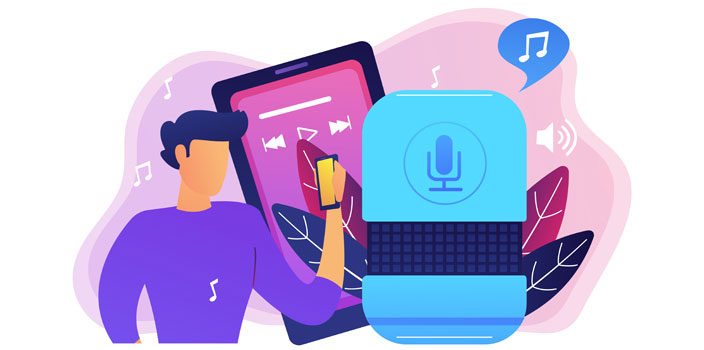Page: 1 | 2

Download our free e-book to find out.
Can technology find a cure for COVID-19? It is still too early to give an answer to this question, although researchers are working on it.
If we change the question as “Can technology help us to handle these difficult times?” We don’t need time to find an answer. The answer is obviously, “Yes.” Because like a godsend, technology is helping us transform the way we work and the way we live.
Being prepared with a digital workforce and digital technologies paid off. Thanks to advanced digital technologies, millions of people easily adapted to the changes due to social isolation concerns. Schools managed to switch to online classes so that education was not interrupted. Millions of employees continue to do their job without leaving their homes. And many companies continued to serve their customers without needing physical contact points.
And AI was on the stage as always. Conversational AI technologies enabled us to reach brands easily whenever we need them. We continued to get the high-quality service as we used to do simply by interacting with a chatbot, a virtual assistant, or a speech-enabled IVR system.
A crisis means a shaky ground for your brand’s image. If you can’t provide your customers with what they need on time, this might damage your brand. On the other hand, offering your customers consistent self-service across any channel, they prefer would help you to turn the crisis into an opportunity for your business. And to achieve this, you can get help from Conversational AI.
As Sestek Marketing Team, we prepared a playbook to guide you through your Conversational AI journey. By downloading our free e-book, you will learn about the definition of Conversational AI, along with technologies supporting it. You will also see an industry snapshot that defines today and tomorrow of the technology. You will dive into the benefits of conversational AI, with a list of products that include this technology. And the final section of our e-book which was designed as a playbook aims to guide you through the implementation of the technology in your own business.
Source: https://www.sestek.com/2020/05/conversational-ai-strengthens-business-in-tough-times/
Publish Date: May 4, 2020 |

With any tool, technique, method or system they developed, humans lead to reorganization of the natural, spatial, temporal conditions which created and defined them. Let’s take AI, for example.
There is no field where AI does not interfere, interact, lead to change, or improve. Of course, one of the most important issues of our life is health. And the use of artificial intelligence in health has already started to transform this field.
Physicians have been performing analysis, diagnosis and treatment for hundreds of years. They accumulate and convey what they know and experience verbally and in writing. This is how medical science / art / profession has evolved and continues to evolve. Of course, medicine is not an isolated field, developments in the fields of biology, anatomy, physiology, etc. have led to the development of medicine. Moreover, the development of engineering disciplines, the development of many fields from genetics to imaging, from biomedical devices to hygienic issues have greatly contributed to the development of medicine and human health.
Especially, the amount of data growing day by day and the increase of analytical applications will contribute to the development of analysis, diagnosis and treatment methods. As the work done previously by human mind is done through the algorithm, error rates will decrease, sensitivity will increase and as a result, more lives can be saved, life expectancy will be longer, health quality will increase, health spending will decrease.
Especially if AI comes into play, human errors will decrease, sensitive diagnoses beyond the human mind will be made, the best treatments can be developed based on the data collected worldwide, even preventive measures can be taken based on the predictions, and recommendations and actions can be produced to eliminate diseases.
Medical Solutions Powered by AI
We can already talk about many medical solutions powered by AI. The first examples that come to mind are applications related to personal health assistance. One of them is ADA. Ada’s core system connects medical knowledge with intelligent technology to help all people actively manage their health and medical professionals to deliver effective care.
Another one is Apple’s iOS Health. This health app consolidates data from your iPhone, Apple Watch, and third-party apps you already use, so you can view all your progress in one convenient place. You can see your long-term trends, or dive into the daily details for a wide range of health metrics.
The use of artificial intelligence in medicine is no longer a myth. Now, the greatest assistant of doctors in every field are algorithms, machine learning systems and robots equipped with many abilities…
AI revolutionizes health as it does in every area of our lives. Health services worldwide are also significantly affected by this change. Machine learning and AI affect physicians, hospitals, and all other health-related areas.
According to Eric J. Topol’s article published in the journal Nature Medicine, everyone in the healthcare industry, from specialist doctors to first aiders, will use artificial intelligence technology in the near future.
According to GE’s projection, the artificial intelligence market for the health sector will exceed $ 6.5 billion by 2021. Considering that 39 percent of decision makers in the health sector plan to invest in machine learning and predictive analysis systems, this figure will increase further in the coming years.
How will AI Contribute to Our Health?
So, how will AI, ML and algorithms create changes in hospitals and contribute to our health?
AI-supported Diagnosis
We can say that the most benefited area is and will be the diagnosis of diseases. Accurate detection of diseases requires years of medical education. Diagnosing even after this training, is challenging and time- consuming. In many areas of medicine, the fact that the demand for specialists has exceeded the supply puts physicians in stress, and the diagnosis of diseases is further delayed.
Machine learning - especially deep learning - algorithms have made great progress in the automatic diagnosis of diseases recently, making the diagnostic process cheaper, easier, and more accessible.
Machine learning is useful in the following similar areas, where the diagnostic information examined by physicians is digitized:
– Lung cancer and stroke diagnosis by analyzing computed tomography scans
– Determination of the risk of sudden heart attack by analyzing electrocardiograms
– Classification of lesions by analyzing skin images
– Determination of diabetic retinopathy indicators by analyzing eye images
Thanks to the abundant data available in these areas, algorithms can be as successful as specialist physicians on the diagnosis. The only difference is that algorithms can diagnose in a very short time and can do this cost-effectively from anywhere in the world.
AI is especially popular in the field of Radiology. More than two billion chest X-rays are taken each year in the world. According to the researches, AI algorithms are more successful than people in evaluating these X-rays and diagnosing diseases. In addition to X-ray films, these algorithms are used in all kinds of medical imaging systems such as CT, MR, echocardiogram, and mammography, and results are obtained at speeds up to 150 times compared to humans.
According to studies, physicians spend much more time on data entry and desk work than they do actually talking to and engaging with patients. When processes like data entry and analysis of test results are automatedAI systems will alert and inform doctors about potential problems, enabling them to be more interested in patients and interpret signals more healthily. Considering that the world population is getting older and the need for a doctor is increasing, every second gained can lead to the survival and prolongation of many people.The question of whether AI or physicians are also on the popular side of the issue. In emerging countries such as China where there is an acute shortage of trained doctors, “Doctor vs. machine” competitions are very popular. This is illustrated by the Chinese TV broadcast of the brain tumour diagnosis and progression prediction competition between a team of 25 expert doctors against the Biomind artificial intelligence (AI) system. The 2:0 win of the AI over the humans in analyzing brain images gained high visibility in China.
AI-supported Surgery & Drug Development
Another area where artificial intelligence is used in medicine is surgery. AI systems can guide surgeons during the operation by analyzing patient data before surgery. Systems can also combine data on past surgeries and develop new and more effective surgical techniques. Researches show that complications are reduced by five times, and hospital stay is reduced by 21 percent in AI-supported operations.
Another field that uses artificial intelligence is drug development. Developing drugs is a very expensive process. The majority of analytical processes during drug development can be carried out much more effectively by machine learning. This will shorten years of work and reduce millions of dollars of investment.
AI is successfully used in all four basic stages of drug development:
– Determining the targets to be intervened
– Identifying potential drug candidates
– Acceleration of clinical trials
– Finding biomarkers for the diagnosis of the disease
AI-supported Personalized Treatment
The last area powered by AI on which I want to talk about is Personalized Treatment. Different patients react differently to medications and treatments. Therefore, personalized treatment is critical to prolonging patients’ lifespan. However, it is not easy to identify the factors used to determine which treatment method to choose.
In the article of Doctor Bertalan Meskó, who describes artificial intelligence as “the stethoscope of the 21st century,” it is stated that AI will make the “uniform” treatment history and suggest personalized treatments, therapies, and medications.
Machine learning can automate this complex statistical study and identify indicators that will be used to determine the patient’s response to a particular treatment. The system learns this by cross-evaluating similar patients by comparing the treatments and results applied to patients. The resulting predictions can make it easier for doctors to determine which treatment to apply.
For example, colorectal cancer patients in Brazil usually refuse the surgical removal of the colon because of cultural reasons. That’s why oncologists turn to methods such as radiotherapy and chemotherapy. However, only 20 percent of patients respond positively to these methods. So, how will it be determined which patient is in this 20 percent group? Here, deep learning algorithms come into play. Algorithms scan the data of patients and determine the appropriate treatment method in a short time and accurately.
AI and the Coronavirus
It is obvious that AI makes remarkable contributions to healthcare. And a question comes to mind since it is high on the agenda: What about coronavirus? Although the spread of the virus is a very recent development, AI-powered applications for virus diagnosis have already appeared. AI company Infervision launched a coronavirus AI solution that helps front-line healthcare workers detect and monitor the disease efficiently. Imaging departments in healthcare facilities are being taxed with the increased workload created by the virus. This solution improves CT diagnosis speed, they claim. Chinese e-commerce giant Alibaba also built an AI-powered diagnosis system. They claim it is 96% accurate at diagnosing the virus in seconds. Let’s hope that AI contributes to the development of an ultimate solution to stop the spread of the disease.
Conclusion
The global willingness to use artificial intelligence and robots is increasing.We can say that the main factor in this increase is the desire for faster, intuitive and low-cost health services. Trust in technology is critical for increased use and acceptance; however, ‘human relations’ remains a key component of the health care experience. So, it looks like we will be able to get the most effective results when we combine the power of AI with humans.
Source: https://www.sestek.com/2020/03/artificial-intelligence-ai-the-secret-weapon-for-healthcare/
Publish Date: March 28, 2020 |

ProPublica’s survey had revealed that the risk assessment algorithm named COMPAS and AI behind the system tends to identify blacks as more risky than whites.
The famous trolley dilemma on ethical philosophy asks: “would you kill one person to save five?”. In this question, you are asked to imagine you are standing beside some tram tracks. In the distance, you spot a runaway trolley hurtling down the tracks towards five workers who cannot hear it coming. Even if they do spot it, they won’t be able to move out of the way in time.
As this disaster looms, you glance down and see a lever connected to the tracks. You realise that if you pull the lever, the tram will be diverted down a second set of tracks away from the five unsuspecting workers. However, down this side track is one lone worker, just as oblivious as his colleagues.
So, would you pull the lever, leading to one death but saving five?
This is the crux of the classic thought experiment known as the trolley dilemma, developed by philosopher Philippa Foot in 1967 and adapted by Judith Jarvis Thomson in 1985.
The trolley dilemma allows us to think through the consequences of an action and consider whether its moral value is determined solely by its outcome.
The trolley dilemma has since proven itself to be a remarkably flexible tool for probing our moral intuitions, and has been adapted to apply to various other scenarios, such as war, torture, drones, abortion and euthanasia.
Of course, there is not a single correct and moral answer to this question about how people think when deciding on an action. However, it is estimated that many people answered this question as “yes, I pull the lever, I can sacrifice one worker to save the lives of five workers”. Also, this answer can be found moral by many people.
Today, apart from philosophy, this dilemma is brought to the agenda by adapting to artificial intelligence. Although there are no AI implementations that can think like a human and make moral judgments, it is often expressed by scientists that we’re approaching this. Of course, how these dilemmas can be solved by AI is of utmost importance. Especially considering that driverless cars will come to traffic in the next ten years, Though not expected of it, AI is thought to have to make some decisions and achieve moral results. On the other hand, it is often mentioned that the possibility of artificial intelligence applications and robots equipped with AI can pose a greater danger than leaving people unemployed. The danger is racist and sexist bias and prejudices in decisions made by AI. Research on the results of AI algorithms used in a number of experiments and decision making processes gives an idea about the magnitude of this danger.
Recently, A research conducted by MIT is particularly remarkable. In this research, the application of artificial intelligence, which is expected to recognize and distinguish the thousand photos uploaded to it, differentiates whites in a perfect way, But, When it comes to blacks it starts to make a big mistake. When the person in the photo is a white man, the software is right 99 percent of the time.
But the darker the skin, the more errors arise — up to nearly 35 percent for images of darker skinned women, according to a new study that breaks fresh ground by measuring how the technology works on people of different races and gender.
Research shows that speech examples used to train the machine learning application is likely to lead to bias. Such problems with the technology have been evident in popular tools such as Google Translate. Recently, while translating Turkish to English Google Translate matched a number of jobs and situations with men and some with women (for instance the sentence “o bir aşçı” translated as “she is a cook”, the sentence “o bir mühendis” is translated as “he is an engineer”) and of course the sexist bias of these translational content has been the subject of debate.
As most of you may remember, a recent example of the biased AI is An AI application developed by Microsoft. In 2016, Microsoft launched the chat application called Tay, which learned human behavior using artificial intelligence algorithms and interacted with other users on Twitter with what she learned. Tay was designed to learn to communicate with people and tweet with data provided by other users on Twitter. In sixteen hours, The tweets she created with the data she collected from Twitter users became sexist and pro-Hitler. On March 25, 2016, Microsoft had to close Thai by apologizing to all users for these unwanted aggressive tweets.
In the text of the apology, Microsoft stated that “artificial intelligence has learned with both positive and negative interactions with people” and therefore “the problem is as social as it is technical”. In fact, this seems to be the highlight of an entire discussion. It can also be clearly seen that although Thai was taught very well to imitate human behavior, she was not taught to behave correctly or morally.
As all these examples clearly show, The racist, sexist, or in some cases status bias produced by artificial intelligence arise from the data sets used to train AI. The datasets used by artificial intelligence algorithms are of course collected from the internet, which is the biggest resource. For example, Microsoft’s Thai who tries to tweet and interact with people in this way, or Google Translate are trying to learn the words, how and with which other words they are used together, so they try both to capture the meaning and to produce answers using natural language against what they understood. Artificial intelligence establishes some relationality through its algorithm while it’s learning which words, how and with which other words these words are used statistically in the datasets provided from the internet. These can sometimes be relationalities whose cause is not understood by human. But in any case, these are not artificial intelligence produced by itself, but the relationalities that exist in the data set that it uses. Therefore, it can match feminen pronouns with cooking, cleaning or secretarial jobs and masculine pronouns with engineering. In other words, the issue appears not as the prejudices of artificial intelligence, but as data sets used in the learning processes of algorithms. That is; racist and sexist content of the internet where this data is collected makes AI produce biases.
As said in the Microsoft statement, social causes rather than technical reasons lie at the root of the problem. While AI learns with the data produced by real people, it can learn to behave like a human, it can analyze the data much faster than the human mind, but at last it cannot learn whether this behavior is right or wrong. But on the other hand, do people always act “good” and “right” in the real world? Maybe, As those who claim that artificial intelligence is not biased, AI produces the most realistic results, but expectation is to see the most suitable results for an ideal world. Considering that there are inequalities and prejudices in the world we live in and the historically produced data is biased, there is no surprise that AI applications also make biased decisions and have real world bias in their decisions. On the other hand, while answering the question “Would you kill one person to save five people?”, It is not unlikely that AI would take into account the race and sex or status of these people, that is, making the dilemma deeper.
Humans shouldn’t be a single source in AI Training
Maybe it is not a very good idea for artificial intelligence to learn merely from people. It is certain that alternative learning ways for artificial intelligence, data sets that are meticulously prepared, cleaned from prejudices and bias as much as possible or algorithms showing how the AI came to which result and how will allow us to progress on these problems. When these are possible, there may be some things that people can learn from AI. Then, It may also be possible for us to negotiate the trolley dilemma and its variations with AI.
Source: https://www.sestek.com/2020/02/a-new-world-without-artificial-stereotypes-and-biases-with-artificial-intelligence/
Publish Date: February 7, 2020 |

We saw a tremendous increase in the use of voice technologies in 2019. Conversational AI, voice recognition and NLP were among the popular technology concepts of the previous year. It is not hard to guess that the rise of voice technologies will continue in 2020. But we still have some questions to answer: What kind of use cases will we see? Which technologies will keep their growth? In short, what will 2020 mean for voice technology? We tried to answer these questions below. Here are the seven trends that will drive voice technology in 2020.
- Conversational AI will be part of business strategies
Today, brands know that voice as a natural interface not only means easier transactions for customers but also higher efficiency for their operations. That is why an increasing number of businesses incorporate conversational AI technologies into their strategies, and this will continue in 2020.
Conversational AI will transform into a must-have feature from a nice-to-have innovation project. Businesses will use voice as a significant differentiator. But offering voice-based solutions will not be enough to differentiate. Customer experience will still be the underlying key factor. In other words, the ones who offer personalized voice experiences will be one step ahead of competition.
- Voice interface design will gain importance
Voice is the interface for anything smart. Businesses already discovered the power of voice interface. And this year they will do more to benefit from this power. Although voice-enabled technologies are hitting the mainstream, there’s room for improvement in terms of the user interface. Users are expecting more natural dialog flows while interacting with devices.
To design effective interactions, understanding how people naturally communicate every day is important. In other words, designers need to consider the fundamentals of voice interaction and design dialog flows in a way that answers users’ high expectations.
- Voice commerce is here to stay
With the increasing use of conversational platforms, voice search is becoming mainstream. This new method offers practical experience for customers. Within a matter of seconds, customers can search for a product and verify their purchase by simply speaking to a voice-integrated device.
With the maturity of voice assistants and improvements in conversational technologies, 2020 will see a noticeable increase in voice commerce. Businesses will work hard to adopt this new form of commerce. They will take voice search seriously and include voice search optimization tactics in their strategies. More to do for marketing teams to explore this new channel!
- Voice-activated wearables will expand
Voice plays a vital role in the expansion of wearables. Voice technology transforms these devices into voice-activated ones and helps users to get the most out of these devices.
We have seen watches, earphones, headsets, fitness trackers as common wearables. With 2020, we will see new forms of wearables. Smart jewelry, such as rings, wristbands, watches, and pins, are among them. These new devices can engage with voice assistants. So, they can offer the same skills many of these assistants offer.
In 2020, increasing use of augmented reality technology will also influence the expansion of wearables. We know that Apple is working on a new AR headset. Similarly, major technology vendors are expected to enter this field by developing their own wearable devices.
- New platforms and applications for voice
The increasing use of voice technologies will increase the need for new platforms for voice-enabled applications. Apple is expected to launch a new platform that will enable developers to create voice-based apps for Siri.
The number of Skills and Actions for voice assistants such as Amazon Echo and Google Assistant will also increase. These features will support not only voice assistants but also new use cases, including earbuds and in-car applications.
All these developments will allow brands and third-party developers to have a presence on voice platforms. So, voice technology will continue to be an effective channel for consumer apps.
- We will see a content transformation
People starting to see voice assistants as parts of their daily routines and use voice search increasingly. That is why more publishers create voice-based content to engage with their target customers.
This trend is expected to continue in 2020. Content strategies include voice as a new format. And not only publishing and media companies but also popular brands will adopt this new form of content.
The increasing use of voice content will influence marketing too. We will see more examples of voice-based advertising. Voice dialog ads will be used to offer interactive marketing experiences for customers.
Conclusion
From consumer applications to enterprise solutions, voice technology has been used as a tool for transformation. By converting devices into voice-controlled systems, voice technology ensures a practical use for customers while offering self-service advantages for businesses. People are getting more used to voice-based systems, and more businesses include voice-enabled technologies in their portfolios. So, it is obvious that voice will continue to be an essential part of our lives in 2020.
Source: https://www.sestek.com/2020/01/what-will-2020-bring-to-conversational-ai/
Publish Date: January 23, 2020 |

VITAL STEPS TO GET THE BEST OUT OF SPEECH ANALYTICS
Here’s the bottom line. Speech analytics is a must-have solution if you are willing to increase the effectiveness of your contact center. DMG Report’s estimation shows us that the adoption rate of speech analytics on a worldwide basis was 35% as of 2019, assuming that there were 19,5 million contact center seats at the end of 2018. Close to 7 million seats benefit from this technology.
However, you must have a clear vision of what you’ll do with such a solution like this. Most of the customers can’t get enough of speech analytics because they don’t know what to do and how to do with the valuable data they have in their hands.
I’ll try to give a couple of tips that can be useful if you have, or plan to have speech analytics;
WHAT TO DO
First, you must define what you expect to do with speech analytics. These expectations generally lead you to three basic outcomes;
- Cost optimization
- Increase Agent performance
- Increase customer satisfaction
So, you must think of what to do to reach these outcomes. For example, ATT (Average Talking Time) analysis leads you to take actions for reducing overall ATT averages and these actions’ outcome is cost optimization. Setting up AQM (automated quality management) forms and integrating them with your agents’ performance management leads you to agent performance increase. Thus, you must have a couple of clear and outlined plans before jumping on the speech analytics world.
HOW TO DO IT
To get the most out of speech analytics, you’ve cleared your targets and now you know where to go. To reach your destination, there are 3 steps that you must go thru:
Preparation of data: You have a huge amount of transcribed data, that’s brilliant. You can see every call’s transcription by double clicking on it and yes, it is very fancy. However, the data is still huge, and you must structure your data to make sense of it. Speech analytics products offer different features like queries, topics, categories and by using these features. You can find the complaining customers and see in which call category your customers are complaining the most or see which of your calls categories have the highest ATT averages.
This is important because that you can extract specific types of data sets from thousands, or sometimes millions of interactions.
Getting deeper: Imagine that you’ve found out you have the highest ATT averages in a certain call category. Now what? Most of the speech analytics users waits for the speech analytics systems to hold their hands and take them to the action phase by themselves. In truth, speech analytics only shine a light on your path to action phases. You have to plan and take these steps.
After you have found a lead like above, you can use the root-causes analysis features of speech analytics products to dig out the insights. At this step, speech analytics show you what to find such as the words/sentences that are being used the most. Or point out thee conversational metrics like hold duration averages, silence ratios etc. You are to decide which makes sense or which doesn’t. Because no other product or team knows your operation better than you.
Take action: So, you’ve found the main reason behind the call category which has the highest ATT averages. Let’s say that agent desktop applications work very slow and because of that you’ve seen the average hold duration is high, agents generally use phrases such as “my screen is slow” etc. Now it’s the time to act. That’s where you shake hands with speech analytics and thank it for its services, because now the ball is in your court to fix this problem with your IT department. You have solid proof about the problem, and it is your responsibility to organize related teams on how to fix it. If you take action, observe and see that the average ATT for this certain category has been decreased, congratulations, you’re ready for your next mission with speech analytics.
Author: Fahrettin Yılmaz, Presales & Partner Enablement Consultant
Source: https://www.sestek.com/2019/11/vital-steps-to-get-the-best-out-of-speech-analytics/
Publish Date: November 25, 2019 |

How likely am I to cancel my bank account if I decrease the number of my routine transactions? Or what if I pronounced “I don’t like this” or “your competitor X does it the other way” to an agent during a call center conversation? Compared to an average customer, probably I would pose a higher risk of leaving this company. Maybe if the agent had the prior knowledge of me being risky, he/she would present a special promotion to me during the conversation and prevent this possible churn.
Considering that gaining a new customer requires much more effort and resource than keeping an existing customer, why take the risk of churn if there is a possibility to be alarmed before it happens?
Analyzing Customer Behavior
Collecting and analyzing past customer behavior is a need for sure. From small entities to large corporates, many organizations use these data to improve their services and enhance customer experience. However, it is not enough for today’s interaction dynamics. Companies have to be informed not only about the customer’s past actions but also about the customer’s possible behavior soon. It wouldn’t be wrong to say that being informed about the customers’ past actions is something; however, using this information to predict customers’ future behavior is a game-changer.
How Predictive Analytics Helps?
According to Markets and Markets, the Predictive Analytics market size is expected to grow from USD 4.5 Billion in 2017 to USD 12.4 Billion by 2022, at a Compound Annual Growth Rate (CAGR) of 22%. The main reason for this expected growth is being associated with the increase of the companies’ interests for forecasting future.
Predictive Analytics plays a critical role in predicting customer actions before they occur. It uses historical data to identify possible future behavior with the help of statistical algorithms and innovative machine learning techniques. For instance, historical data of customers that canceled their membership in the past would be a prior ingredient to train reference models for the “churn prediction” case. These models, which are trained for different scenario cases, can be used to make comparisons with the newcomer data. Thus, it would be possible to see if customers matching with these patterns and to flag the interactions accordingly.
Predictive Analytics can also be used to detect fraudulent behavior before any serious damage is inflected. Companies can notice unusual activities in time that may cause incidents ranging from credit card fraud to fake identity calls.
Sestek Predictive Analytics
Besides typical historical data such as transaction data, demographic data, etc. the call center conversations also give valuable information about behavioral patterns. As an AI-based analytics company working on speech analytics, Sestek can create extensive prediction scenarios.
Sestek’s Speech Analytics solution currently analyzes acoustical and textual information of 1 out of 4 contact center calls in Turkey, which makes the case easier to expand this knowledge to get further insights about future customer intent. Sestek records, transcribes, and analyses the calls between the customers and the call center agents by its own tools and combines these outcomes -like the speaker’s emotional behavior and tone- with further customer data to build reference prediction models for Sestek Predictive Analytics solution. These prediction models are trained for specific cases according to the organization needs. So far, our studies showed that Predictive Analytics can be beneficial for churn, fraud, and collection scenarios. It can be used to provide real-time agent guidance, next-best-action recommendations, or optimal marketing/sales offers for the benefit of both the customers and the organizations. Each new data bolsters up the machine learning algorithms and becomes more and more reliable compared to the instincts of agents.
Sestek Predictive Analytics is an ongoing project that has been financially funded by The Scientific and Technical Research Council of Turkey (TUBITAK). We “predict” that this new member of our analytics family will complement our solutions suite and present more comprehensive insights and actionable results for our customers.
Author: Tuba Arslan Kır, Sestek R&D Coordination Team Leader
Source: https://www.sestek.com/2019/10/anticipating-customer-intent-better-with-predictive-analytics/
Publish Date: October 31, 2019 |  | 1 |
As AI continues to rise, it radically changes how work gets done. From consumer goods to telecommunications, from healthcare to financial services, an increasing number of businesses use AI to improve productivity.
This brings along a question: Will AI replace humans?
Researchers say no.
Harvard Business Review’s survey found out that companies which optimized collaboration between humans and AI obtained better performance results in terms of speed, cost savings, revenue, and other key operational measures.
According to Accenture’s report, entitled “Reworking the Revolution,” higher investment in AI and human-machine collaboration could increase revenues by 38% and boost employment by 10% by 2022.
So, it looks like AI is not here to replace us. Instead, we can get the best out of this technology by collaborating with it. Many industries have already combined humans with AI technologies to ensure efficiency and contact centers are among them.
How Contact Centers combine AI and humans?
As the flagships of customer services, contact centers were considered as cost centers. To overcome this, organizations searched for effective ways of cutting costs without sacrificing customer experience. AI-based self-service solutions were the answer.
AI-based self-service solutions enable call centers to automate various tasks with the help of the latest technologies, including chatbots, virtual assistants, conversational IVRs. These technologies enhance customer experience by shortening transaction durations and offering fast and practical answers to customer needs. These self-service automation solutions include various forms of human-AI collaboration to ensure enhanced experience and higher efficiency.
AI-assisted humans
In many call centers today, a customer starts to interact with an AI solution to accomplish a task. This might be a chatbot, a virtual agent, or a conversational IVR menu. Thanks to developments in natural language processing technology, these AI solutions have advanced conversational capabilities. Unlike traditional versions that can only give simple yes-no answers, today’s conversational AI technologies can understand what customers really mean and offer the right solution accordingly.
This means many interactions can start and end with an AI solution without the need for a live agent.
On the other hand, in some applications, AI technologies can provide real-time guidance to agents. So, they don’t need to search for specific information while providing support to customers. AI technologies show the necessary information and save agents from causing long wait times for the customers.
So, when implemented in call centers, AI-based self-service solutions help agents by decreasing their workload and allowing them to spend less time on operational tasks and focus on more crucial tasks.
Human-assisted AI
Human-assisted AI applications aim to help AI technologies to become more accurate in less time. Because the success of AI heavily depends on the data and training methods that are used to fine-tune it, human assistance can help speed up this process.
When implemented in call centers, these applications boost the benefits of AI by eliminating the drawbacks of possible inaccuracies. For example, call center agents step in when AI shorts fall in understanding a customer need or providing an answer accurately. This not only prevents an error that might result in customer dissatisfaction but also trains the system in the long run. Each human intervention helps AI technology to be trained and offer better answers in the following interactions.
A patented technology that combines AI with agents
Sestek’s patented Seamless Agent technology is an example of human-assisted AI. This technology supports AI solutions such as chatbots, conversational IVR, and virtual assistants with live agents. Seamless Agent depends on the idea of preventing any mistakes which AI could make with the help of agents.
For example, when a customer is interacting with a system, and the system detects a customer phrase with low-confidence recognition values, it sends them to a human agent for assistance. The agent then corrects or verifies the decision within seconds before sending it to the customer. This provides a seamless and flawless experience without the customer, even realizing it.
In a short period of time, the need for live agents is minimized due to the increased learning capabilities of the system. The more the system learns, the less assistance of a live agent is required.
Join Our Live Demo
To learn more about Seamless Agent technology, register to our live demo, which will be on Wednesday, August 28th, 2019, at 2:00 PM Istanbul time (+03). At this live demo, our Pre-Sales Director will explain in detail the features of our patented Seamless Agent solution and how it enables the perfect collaboration between agents and AI for that ideal customer experience.
Source: https://www.sestek.com/2019/08/boost-call-center-performance-with-ai-and-agent-collaboration/
Publish Date: August 19, 2019 |
When it comes to audio forensics, many of us can easily imagine a scene where some serious-looking guys listen to an audio recording while looking at an audio waveform on a computer screen.
Thanks to increasing media coverage about dramatic court cases and popular fictional entertainment series like Crime Scene Investigation, everybody is now familiar with audio forensics.
What Is Audio Forensics?
As a field of forensic science, audio forensics combines audio engineering and digital signature processing techniques to evaluate audio data as part of a legal proceeding or an official investigation.
Before being used as a piece of evidence, audio data is evaluated in terms of its authenticity, any modifications it includes, and its relevance to the goals of the investigation. Audio evidence can be obtained from different resources, such as an acoustical recording system (such as a cockpit voice recorder), a call center recording, a voice mail message, or a surveillance tape acquired during a criminal investigation.
Audio Forensics Tools
Voice is a biometric identifier because, like fingerprints and retinas, each voice is unique to one individual. Therefore, a person’s voice can distinguish her from others, making it possible to identify a person by comparing her voiceprint with the recorded voiceprints of other people.
Audio forensics tools use voice biometrics technology to analyze voice and assist forensics experts in their crime prevention and investigation efforts.
By using these tools, forensics experts can:
- Determine whether a voice belongs to a specific person
- Test to see if a recording has been edited or altered
- Compare a target speaker with a database of possible candidates
- Accurately match an individual’s identity with the audio evidence content
- Verify an individual’s identity with an audio recording
Benefits of Forensic Voice Analysis
Accurate Investigation Results
Forensic voice analysis solutions answer law enforcement and crime prevention needs by offering comprehensive forensic audio mining capabilities. These audio forensics tools contribute to securing justice by providing courts with proven biometric identification results.
With advanced voice biometrics features, forensics experts can easily detect samples of speech in an audio recording and identify speakers in just moments, no matter the gender, language, accent, or speech content involved. These biometrics features include:
- Speaker identification, which confirms or disproves the identity of an individual by analyzing audio evidence
- Speech-silence detection, which automatically detects speech or silence in audio samples and labels different sections appropriately as one or the other
- Formant verification, which allows for one-to-one comparisons of formant distributions of audio recordings
- Speaker diarization, which differentiates between multiple voices in a single-channel recording of speech
- Gender identification, which automatically detects the gender of the speaker
Together, these features ensure identity verification with high accuracy.
Faster Investigation
Forensics experts are racing against time, because every moment counts in a criminal investigation. Forensic voice analysis tools help law enforcement and security experts save essential time in prosecuting suspects.
Audio forensics tools analyze up to hundreds of audio files in just a few minutes. This far outpaces the amount of evidence a human could review in the same amount of time. Users may compare several audio recordings at the same time, including any audio evidence that is relevant to the investigation. Rather than listening to each one individually—which could take hours and hours—users can quickly narrow in on a suspicious individual’s identity in moments.
With fast, visualized voice biometrics, forensic voice analysis tools enable experts to assess audio evidence at a glance. Thus, they can complete voice treatment and speaker identification in record time, saving hours of time that would otherwise be spent listening to recordings in full.
Practical Tool for Experts
Audio forensics tools aid in criminal investigations by providing a fast, simple, and accurate speaker identification process. They ensure easy-to-use and practical audio analysis for forensics experts.
The tools allow experts to organize and refer to any audio files relevant to their investigation. They also offer multiple archiving features that allow users to archive any analyses in case they are needed in the future.
By offering this practical application, audio forensics tools help experts to complete voice treatment easily, saving not only time but also energy. With this minimized workload, experts can give their full attention to the investigations, which will increase their chances of success.
Sestek Forensic Voice Analysis
Sestek Forensic Voice Analysis is a biometric audio forensics solution. The solution analyzes audio evidence accurately by applying voice biometrics technology in a way that makes it easier to work with audio evidence. It assists forensics experts and security organizations complete voice treatment and speaker identification processes accurately.
Thanks to Sestek’s 19 years of experience in the speech technology industry, the solution provides highly accurate and reliable voice analysis results.
To learn more about Sestek Forensic Voice Analysis, please visit our product page.
Source: https://www.sestek.com/2019/01/using-voice-biometrics-in-law-enforcement-audio-forensics/
Publish Date: January 20, 2019 |
Attracting New Customers Is Expensive
It is always cheaper to keep your current customers than attract new ones. According to the Harvard Business Review, acquiring a new customer is anywhere from 5 to 25 times more expensive than keeping an existing one. This is why you need to find better ways of retaining your customers. One of the best ways is to increase customer engagement, because engaged customers are great brand advocates. They are also repeat buyers who have a direct influence on profitability.
According to Gallup, a global analytics and advice firm, customers who are fully engaged spend 23% more in terms of wallet share, profitability, and revenue than the average customer, so investing in customer engagement builds a strong brand with loyal customers.
Increasing Customer Engagement with Conversational Technologies
Customer engagement is about enhancing the customer experience and encouraging customers to interact. It is also about influencing customers in ways that build long-term relationships.
To increase customer engagement, organizations need to enhance the customer experience by:
- Offering high-quality solutions
- Answering customers’ needs on time
- Being reachable on any channel
- Providing personalized solutions
Conversational technologies are great tools for increasing customer engagement. These technologies include speech recognition, text-to-speech (TTS), natural language processing (NLP), and voice biometrics.
Conversational technologies use voice as a natural interface to facilitate human-machine interaction. Thus, they empower intelligent automation solutions that enhance customer experience and engagement through smart self-service.
By using these technologies, you can cut costs without sacrificing customer satisfaction. With the automation they provide, conversational technologies decrease customer service costs, the need for human workers, and the working hours spent on conventional service approaches.
Conversational technologies can be integrated into any channel, and they are available 24/7. This enables customers to reach your organization any time from whatever channel they prefer. Always being available means uninterrupted service for customers. By using conversational technologies, you can provide effective omnichannel self-service for your customers.
Empower Customers with Qualified Self-Service Through Natural Dialog
NLP-based technologies enable users to interact with any system by using their own words instead of conventional interfaces. These technologies ensure a natural dialog between users and systems and can be used in IVRs, chatbots, and virtual assistants.
By implementing NLP-based natural dialog technologies in your solutions, you can empower your customers to help themselves. These technologies understand your customers’ natural speech and intent and offer them the solutions they need any time from any channel they like. For example, when implemented in IVR systems, conversational technologies allow users to navigate across menu options via natural speech. Time-consuming touch-tone and agent-assisted menu navigations are replaced with everyday language. Customers can reach the right self-service menu option by stating their needs quickly and easily, in their own words.
Another use case for these technologies is chatbots and virtual assistants. These popular applications draw their strength from NLP technology. With the help of NLP, both applications understand the intent and meaning behind users’ statements with high accuracy, answering customers’ questions with ease, no matter how complex they are.
As intelligent automation solutions, natural dialog technologies can help you to increase customer engagement by:
- improving and optimizing business operations
- reducing average handle times
- offering simplified and personalized self-service
- enhancing the customer experience
- ensuring consistent self-service across multiple channels
Enhance Security with Voice Biometrics
Today’s customers are deeply concerned about security, and given the security threats that exist, they are not wrong. Traditional security measures like PINs, passwords, and security questions are poorly equipped to stop the growing incidence of fraud and identity theft.
As a conversational technology, voice biometrics offers an effective security solution. The technology verifies users’ identities via each user’s voice. Everyone’s voice is unique, just like fingerprints and irises, which makes voice authentication far more secure than traditional security measures.
The technology not only increases security but also enhances the customer experience. Conventional security measures like PINs, password, and security questions can be time consuming for customers—and sometimes easy to forget. Unlike these methods, voice biometrics enables reliable identity verification in a matter of mere seconds.
Voice biometrics automates security processes. By using this technology, you can optimize your security processes by replacing manual identity verification. This significantly reduces the number of security steps and time involved in the verification process.
Voice biometrics is a smart approach to identity verification. The technology contributes to customer engagement by:
- saving customers from complicated questions and easy-to-forget passwords
- providing a fast and easy authentication method
- offering simplified and personalized self-service
- increasing security and ensuring data protection
- reducing average wait times due to manual identity verification
Know What Your Customers Think About You with Smart Analytics
To provide your customers with what they are looking for, you need to listen to them. Effectively listening to your customers on their terms and acting on what they say are keys to effective customer engagement.
Customer interactions include a wealth of invaluable insights: the level of customer satisfaction, likelihood of churn, agent performance, campaign effectiveness, and more. However, the sheer volume of these interactions makes it impossible to manually review and analyze them. Manual review can process only a fraction of interactions and is far from providing objective evaluation results.
Interaction analytics solutions, also known as Voice of the Customer, can help you overcome this challenge. With these automated approaches, you can apply in-depth analytics to recorded customer interactions across multiple channels. These analyses include not only textual and statistical details but also emotional ones. With advanced features like emotion detection and sentiment analysis, you can gain valuable insights into how your customers feel.
By applying smart analytics to recorded customer interactions, you can identify and measure the drivers of customer behavior. Acting on customer feedback allows you to implement effective business strategies that improve self-service processes, staff performance, and customer experience. The result is happier and more deeply engaged customers.
Smart analytics solutions help you to gain intelligence from customer interactions by allowing you to:
- capture and analyze customer feedback
- discover what your customers care about most
- understand your customers’ needs and pain points
- gain actionable insights and act on these insights to enhance the customer experience
- improve customer experience and engagement
Learn More
As Sestek, we will be sharing insights into the effective use of conversational technologies at the AVAYA Partner Summit 2019, which will take place on 4–5 December 2018 at the Event Center of the InterContinental Hotel, Dubai Festival City.
Visit our booth to learn more about Sestek’s conversational technologies, including Natural Dialog, Voice Biometrics, and Voice of the Customer.
To learn more about the Avaya Partner Summit, please visit the event website.
Source: https://www.sestek.com/2018/12/engage-customers-using-power-of-conversational-technologies/
Publish Date: December 4, 2018 |
The number of attempts to defraud organizations is increasing each day. Today’s fraudsters are skilled in social engineering—the use of deception to obtain confidential information—and use sophisticated methods. Thus, they can easily gather different kinds of data to use in attacks like identity theft, account takeovers, and fraudulent transactions.
When compared with better-controlled digital channels, call centers are at greater risk. Their dependence on a human workforce increases their vulnerability to fraud. Employee training generally falls short when it comes to sophisticated social engineering attacks, and it is not hard to answer security questions by using compromised customer data. This encourages fraudsters to target call centers.
What Can Call Centers Do?
Traditional knowledge-based authentication methods like challenge questions are no longer enough to prevent fraud. Call centers need to find efficient methods to protect themselves from increasingly sophisticated attacks. This requires a holistic security approach where security and risk management are taken seriously, which means investing in fraud prevention technologies that take advantage of the power of biometrics.
Why Voice Biometrics?
For many organizations, voice biometrics is an effective security measure, and the use of this technology is constantly increasing. According to a recent market study, the global voice biometrics solutions market is expected to reach a value of US$13 billion by 2026, with a compound annual growth rate of 17.3%.
This means that more and more companies are applying voice biometrics to their security needs, and call centers are no exception. Call centers prefer this technology due to following reasons:
It is the only biometric measure for call centers
Voice biometrics is the only biometric measure that can be used over the phone, which makes it literally the only biometric option for call centers, but organizations use it because of its many advantages, not because it is their only option.
Biometric technologies differ from common security measures by being based on unique individual characteristics like the retina or iris. Unlike knowledge-based security methods, a person’s voice can’t be compromised. By analyzing a user’s voice for its hundreds of unique characteristics, voice biometrics offers a convenient and highly secure authentication method. Call centers that aim to implement the latest security technology will choose biometrics, which is really the only option for call centers.
Other methods might fall short in protection
Traditional security measures include a “what you know” factor. PINs, passwords, and mother’s maiden names are all examples of knowledge-based verification questions. Even the most advanced security questions are often based on public information that can easily be obtained by a fraudster. Therefore, knowledge-based authentication doesn’t offer an effective solution against fraud.
On the other hand, biometric verification boasts a “what you are” factor because is based on an individual’s unique characteristics, including voice. A voice can’t be stolen, hacked, or forgotten, which is why voice biometric software offers a more secure authentication method than the alternatives.
Voice biometrics can track fraudsters’ voices as they call across multiple accounts and time periods. Although fraudsters can trick agents, they can’t fool voice biometrics. Thus, the technology reduces call centers’ vulnerability to social engineering attempts.
It can be combined with other security methods
Today’s security-concerned organizations use multi-factor authentication to overcome potential threats. They layer several authentication methods together to deliver the strongest possible security solution. Voice biometrics enables multi-factor security by integrating with a variety of security methods.
If an organization already has a preferred identity verification method, voice biometrics can enhance this method by providing an added element of security. This adds a “who you are” layer to the traditional “what you know” layer of passwords and PINs. For example, single-factor authentication, such as simply entering a password, has been proven to be a weak solution. On the other hand, a password coupled with voice biometrics can guarantee secure authentication.
It doesn’t sacrifice the user experience
Conventional security measures like PINs, passwords, and security questions can be easy to forget and time consuming for customers. Voice biometrics saves customers from the need to remember passwords and the burden of invasive knowledge-based questions.
The technology enables identity verification in a matter of seconds by analyzing users’ individual voiceprints. Seamless and consistent security not only removes frustration but also saves time both for customer and agent. Therefore, voice biometrics reduces stress, saves time, and greatly improves the customer experience.
It supports multiple channels
Thanks to the omnichannel approach, today’s customer interactions have moved beyond call centers. Customers can reach organizations from whatever channel they prefer, including IVR, online, social, and mobile.
Voice biometrics is a natural fit for cross-channel engagement. The technology offers efficient verification in a way that enhances the user experience and provides consistent multi-channel security.
It offers flexibility
Voice biometrics can be deployed on the premises or in a variety of cloud settings to meet organizations’ different security needs. Thanks to the highly customizable structure of the technology, any organization can set up a fast, easy, and powerful security solution within its existing platforms and technologies.
Voice biometrics also offers accent- and language-independent use; the technology verifies user identities strictly by voice, not by their language or accent. This provides flexibility for organizations by allowing them to implement this technology into any operation regardless of location.
It reduces business costs
Voice biometrics significantly reduces the number of security steps and the time involved in the verification process. Agents spend less time with each caller, shortening average call times. This not only saves call centers significantly on overhead costs but also results in happier customers and a more efficient team.
Voice biometrics also reduces the number of fraud attacks by detecting repeat calls from known fraudsters. This contributes to remarkable savings in avoided fraud incidents.
Use Cases: Fraud Protection with Voice Biometrics
Text-Dependent Voice Verification
Text-dependent voice verification offers an active verification method. This technology requires passphrases to enroll and authenticate users. First, users create a voiceprint during the enrollment process by repeating a specific passphrase. In their subsequent calls, they simply repeat this passphrase to verify their identities. The voiceprint of a caller speaking the passphrase is compared with prior voiceprints for authentication.
The technology offers effective security against fraud. It is impossible to impersonate or fool the technology because the user’s unique voice details must be matched with the voiceprint on file. Features like playback manipulation detection, voice change detection, synthetic voice detection, and blacklist identification enhance the power of this technology to combat various security threats.
For example, with playback manipulation detection, the technology recognizes that a captured voice is being played. Voice change detection recognizes when the end user’s voice changes during the enrollment process, and synthetic voice detection identifies cases in which fraudsters modify a recorded voice sample. The technology also checks for known fraudsters by employing biometric blacklist identification during all operations.
Visit the Sestek Vocal Passphrase page to learn more about our text-dependent voice verification technology.
Text-Independent Voice Verification
Text-independent voice verification offers a passive verification method. With this technology, callers don’t need to take a specific action to pass through an authentication process. Unlike active authentication, passive authentication doesn’t require formal enrollment or the repetition of a specific passphrase during authentication.
To use the system, callers must first enroll by calling the call center and speaking. After a customer speaks for a sufficient number of seconds, the system creates a voiceprint that will be used to authenticate them on their next call. Simply by listening to customers talk with agents, the system scores the recording’s relevance by comparing it with the previously enrolled recorded voiceprints. If the score is high enough to accept the user, the security check is passed.
This technology provides the benefit of enhancing fraud protection without troubling users. With such an effortless authentication experience, the technology not only boosts customer satisfaction but also ensures biometric security. Features like playback manipulation detection, synthetic voice detection, and blacklist identification ensure that the technology will not be fooled by fraudsters.
Visit the Sestek Verification On-The-Go page to learn about our text-independent voice verification technology.
Fraud Detection
Biometric fraud detection solutions are used to identify and stop highly specialized fraudulent individuals. Blacklist applications are among the most common fraud detection methods. Based on voice biometrics, these applications detect fraudsters through biometric verification and trigger alarms for anti-fraud teams.
Biometric blacklist application seamlessly identifies users with high fraud potential, then diverts them into a separate queue for call security teams. The application automatically crosschecks every call with the blacklist database after a voiceprint is recorded. It marks those calls that are scored higher than the threshold score and identifies listed fraudsters by their voices, comparing the captured voice with voiceprints stored in the blacklist voiceprint database.
Visit the Sestek Blacklist Identification page to learn more about our biometric blacklist application technology.
Conclusion
Call center fraud is a widespread problem. Depending on human agents increases call centers’ vulnerability to fraud, and fraudsters try to take advantage of the human factor by using different techniques to break through the relatively simply barriers that call centers typically have in place.
Call centers no longer rely on traditional knowledge-based authentication. They know that overcoming constant security threats requires a more effective solution. Therefore, more and more organizations are turning to voice biometrics for effective fraud protection, an enhanced customer experience, and higher call center efficiency.
Source: https://www.sestek.com/2018/11/fighting-against-call-center-fraud-with-voice-biometrics/
Publish Date: November 13, 2018 |

We’ve all experienced that sense of dread: calling a customer support line only to be met with a robotic, confusing phone menu. Finding the menu option that meets your needs can be tough and time-consuming. And once you’ve finally found it,
Natural Language Processing-Based IVR Solutions
As a result of tremendous developments in natural language processing (NLP) technology, IVRs can serve as conversational systems. NLP enables human-like interactions with IVR systems. This means that instead of using a touch-tone menu, customers can state their questions or concerns in plain language. Thus, customers enjoy a natural, intuitive experience that’s just like talking to a live human, without being constrained to fixed menus. This technology not only enhances the customer experience but also increases operating efficiencies for businesses.
Speech Enabled IVR for QNB Finansbank
Sestek customer QNB Finansbank enjoys these benefits thanks to Sestek’s NLP-based Speech Enabled IVR technology.
Before Speech Enabled IVR
Before Speech Enabled IVR, QNB Finansbank used agents to handle calls. Its call center received approximately 2.8 million customer calls every month, which amounts to 90,000 calls a day. QNB Finansbank employed 600 full-time call center agents to meet this need, with the average call lasting three minutes.
Touch-tone menu navigation was causing customers to lose time. This meant not only a bad experience for them but also higher operational costs for the bank. Therefore, it sought a solution that would improve customer experience and cut operational costs.
The Solution
That solution was Sestek Speech Enabled IVR.
Speech Enabled IVR uses NLP to enable human-like interactions with IVR systems. This allows customers to state their demands in plain language to the system without using a touch-tone menu. Sestek Speech Enabled IVR provides several benefits both for organizations and customers.
The solution ensures a natural dialog between users and IVR systems, thanks to advanced technologies like NLP and intent recognition. This frees customers from complicated menu navigation and saves their valuable time.
The technology is an effective alternative to touch-tone IVR systems because it offers a highly automated solution. Speech Enabled IVR guides customers directly to just the self-service menu they need. Providing faster solutions not only enhances the customer experience but also increases efficiency. Faster and more efficient call routing helps customers find solutions faster, reduces calls, and lightens agents’ workload through automation.
The Implementation
QNB Finansbank decided to implement Sestek Speech Enabled IVR in its call center. The two companies’ teams worked closely during the implementation phase. They prepared a to-do list and a project plan to determine what needed to be done. To design the IVR tree accurately, they reviewed actual customer call recordings and made a blueprint of the conversation tree. The teams also applied different tests to ensure that Speech Enabled IVR integrates properly with the current IVR system. The teams continued to monitor the system after the implementation to ensure smooth operation.
After Sestek Speech Enabled IVR
Soon after implementation, QNB Finansbank began seeing several benefits. The solution’s NLP and intent recognition technologies helped the company better understand its customers’ reasons for calling. Customers were matched with the right menu in fewer steps. Thus, the rate of accurate menu navigation increased to 92% and average wait time decreased by 31%. Allowing customers to complete different transactions without needing complicated menu navigation and an agent’s help increased customer satisfaction. Consequently, abandoned calls declined by 39%, while the agent workload decreased by 10%, for a 6% increase in self-service rates.
Conclusion
Although the number of digital channels in customer services is increasing, the contact center remains the preferred choice. Customers also expect the ease of an online transaction from IVR calls. Businesses are looking to offer effective solutions that not only satisfy customers but also decrease costs. Speech Enabled IVR provides an effective solution for this need. The solution ensures practical use by allowing customers to interact with IVR systems via natural speech. This saves customers from complicated menu navigation and wasted time. By shortening call duration and decreasing the need for live agents, the technology also increases business efficiency.
Learn more
For more information about Speech Enabled IVR, you can visit our product page.
Source: http://www.sestek.com/2018/08/enjoying-self-service-benefits-with-speech-enabled-ivr/
Publish Date: August 15, 2018 |
Page: 1 | 2

























 Nathalya Wani Sabu
Nathalya Wani Sabu








 LOGIN WITH YOUR CONTACTCENTERWORLD.COM ACCOUNT
LOGIN WITH YOUR CONTACTCENTERWORLD.COM ACCOUNT
I am checking out all the amazing and daily updated content on ContactCenterWorld.com and networking with professionals worldwide
Send To Friends Post On My Wall